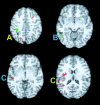Relation between brain activation and lexical performance
- PMID: 12811732
- PMCID: PMC6871810
- DOI: 10.1002/hbm.10111
Relation between brain activation and lexical performance
Abstract
Functional magnetic resonance imaging (fMRI) was used to determine whether performance on lexical tasks was correlated with cerebral activation patterns. We found that such relationships did exist and that their anatomical distribution reflected the neurocognitive processing routes required by the task. Better performance on intramodal tasks (determining if visual words were spelled the same or if auditory words rhymed) was correlated with more activation in unimodal regions corresponding to the modality of sensory input, namely the fusiform gyrus (BA 37) for written words and the superior temporal gyrus (BA 22) for spoken words. Better performance in tasks requiring cross-modal conversions (determining if auditory words were spelled the same or if visual words rhymed), on the other hand, was correlated with more activation in posterior heteromodal regions, including the supramarginal gyrus (BA 40) and the angular gyrus (BA 39). Better performance in these cross-modal tasks was also correlated with greater activation in unimodal regions corresponding to the target modality of the conversion process (i.e., fusiform gyrus for auditory spelling and superior temporal gyrus for visual rhyming). In contrast, performance on the auditory spelling task was inversely correlated with activation in the superior temporal gyrus possibly reflecting a greater emphasis on the properties of the perceptual input rather than on the relevant transmodal conversions.
Copyright 2003 Wiley-Liss, Inc.
Figures







References
-
- Aizenstein HJ, MacDonald AW, Stenger VA, Nebes RD, Larson JK, Ursu S, Carter CS (2000): Complementary category learning systems identified using event‐related functional MRI. J Cognit Neurosci 12: 977–987. - PubMed
-
- Baayen RH, Piepenbrock R, Gulikers L (1995): The CELEX Lexical Database (v. 2) [CD‐ROM]. Philadelphia, PA: Linguistic Data Consortium , University of Pennsylvania.
-
- Binder JR, Rao SM, Hammeke TA, Yetkin FZ, Jesmanowicz A, Bandertini PA, Wong EC, Estkowski LD, Goldstein MD, Haughton VM, Hyde JS (1994): Functional magnetic resonance imaging of human auditory cortex. Ann Neurol 35: 662–672. - PubMed
-
- Booth JR, Perfetti CA, MacWhinney B (1999): Quick, automatic, and general activation of orthographic and phonological representations in young readers. Dev Psychol 35: 3–19. - PubMed
-
- Booth JR, Burman DD, Van Santen FW, Harasaki Y, Gitelman DR, Parrish TR, Mesulam MM (2001): The development of specialized brain systems in reading and oral‐language. Child Neuropsychol 7: 119–141. - PubMed
MeSH terms
Grants and funding
LinkOut - more resources
Full Text Sources

